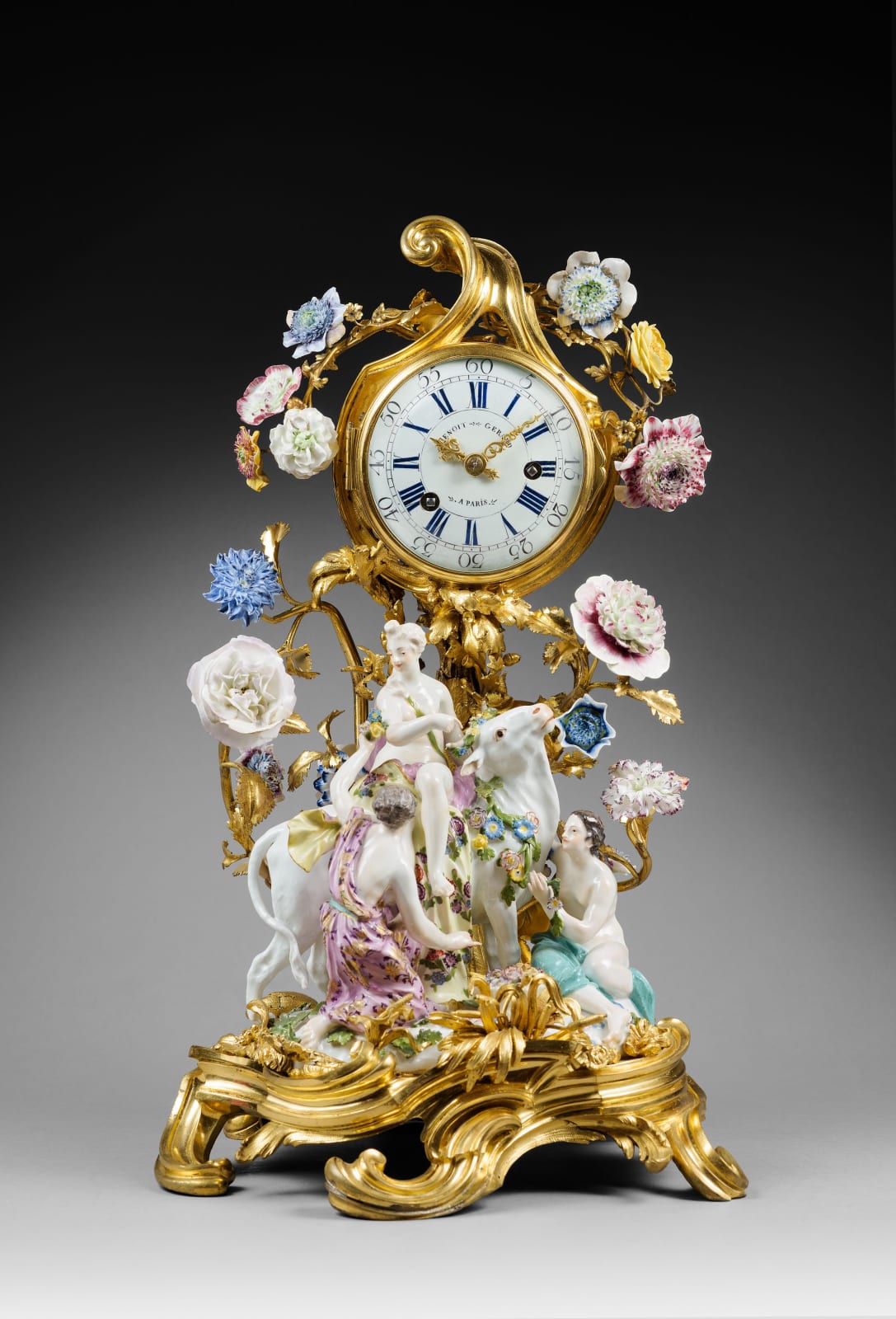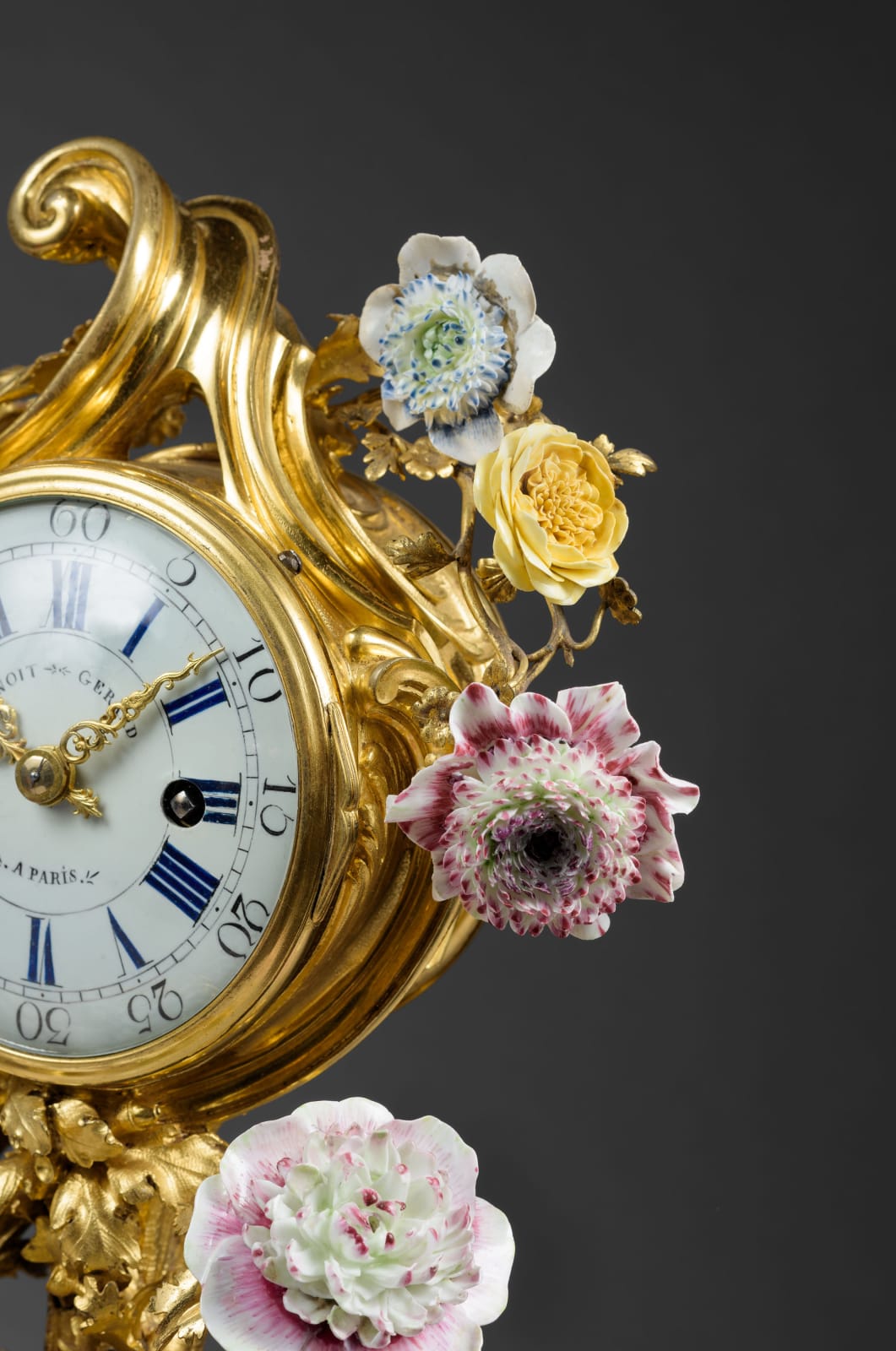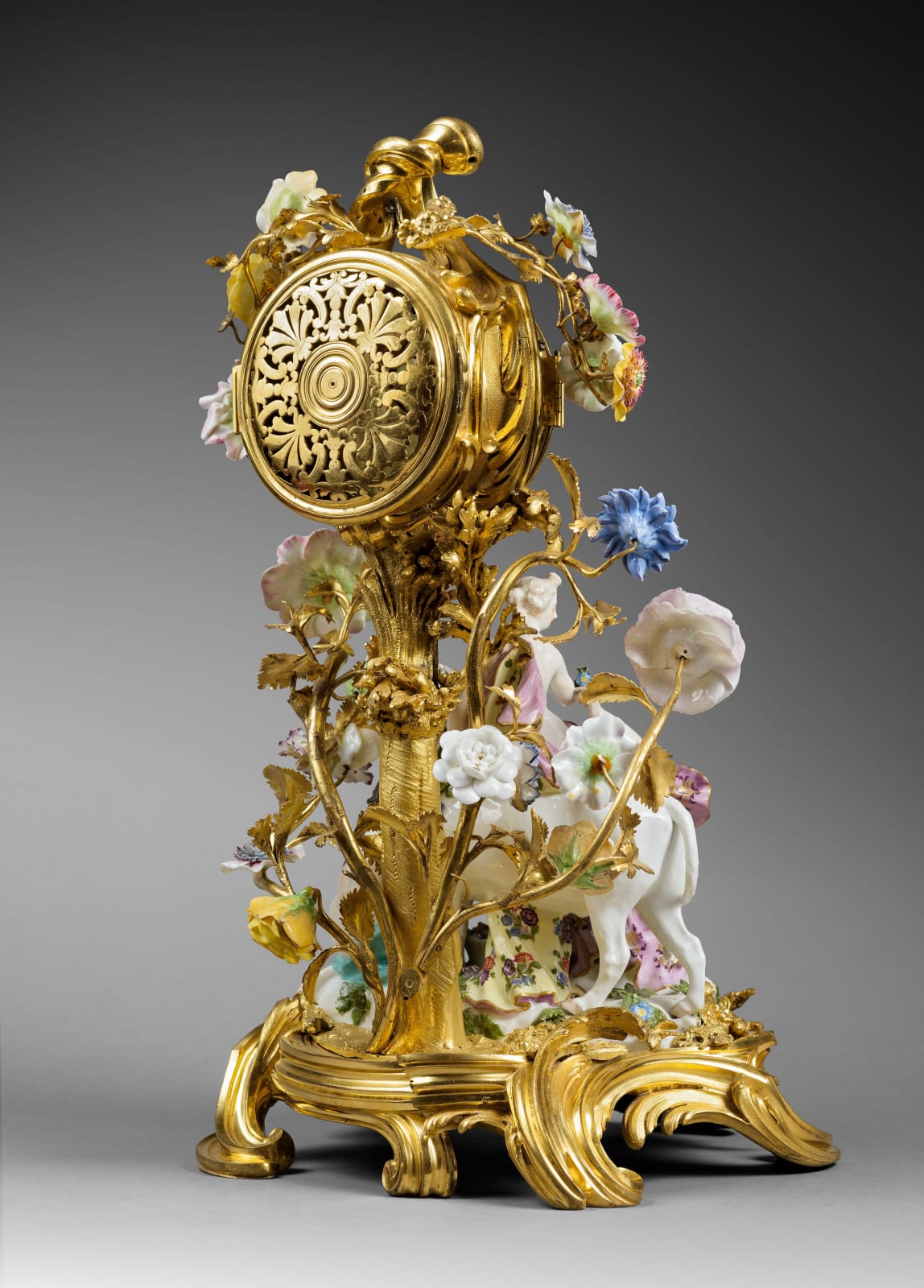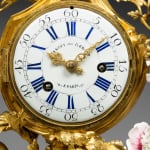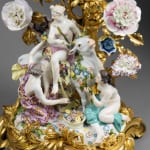Gérard Benoît
Further images
Provenance
Sotheby’s, London, May 16, 1958, lot 91
Literature
Elke Niehüser, “Die Französische Bronzeuhr”, 1997, p. 35, illustrating the same Meissen model of Europa and the Bull in the Kunstgewerbemuseum, Berlin, noted as being modelled by Friedrich Elias Meyer. Abraham Lambertus den Blaauwen, “Meissen Porcelain in the Rijksmuseum, Amsterdam”, 2000, pp. 458-459, no. 334, illustrating the same Meissen model of Europa and the Bull in the Rijksmuseum, Amsterdam.
A rare and extremely fine Louis XV gilt bronze mounted Meissen porcelain mantel clock representing Europa and the Bull of fourteen day duration by Benoît Gérard, signed on the white enamel dial and also on the movement Benoit Gerard à Paris and stamped on the porcelain with the Meissen crossed blue sword mark. The movement with anchor escapement and silk thread suspension, striking on the hour and half hour on a single bell, with outside count wheel, numbered 1-12. The dial with Roman and Arabic numerals and a very fine pair of pierced gilt brass hands for the hours and minutes.
The beautiful cartouche shaped case surmounted by an asymmetrical scroll surrounded by scrolling gilt bronze floral and foliate branches and adorned with exquisite polychrome painted soft paste polychrome painted porcelain flowers, the dial drum supported on a gilt bronze tree trunk issuing foliate branches and further porcelain blooms, in front of which is a Meissen soft paste porcelain group showing the nude figure of Europa seated upon a upon a floral painted cloth draped over the back of a white bull adorned by floral garlands and attended to by two of Europa’s scantily clad handmaidens placed either side of a basket of flowers, one kneeling while offering a posy of flowers to Europa, the other seated in front of the bull, the white beast and handmaidens on rockwork adorned with gilt bronze fruits and foliage upon an asymmetrical scrolling rococo base on pronounced scrolled feet
The porcelain: Meissen, date circa 1750.
The gilt bronze: Paris, date circa 1750
Height 48.5 cm; width 31 cm; depth 26.5 cm.
During the 1740s and throughout the 1750s gilt bronze mounted porcelain clocks reached their apogee, both in terms of artistic perfection and popularity. Considered the height of elegance and beauty, these highly treasured and expensive objects enchanted society by their ingenious ability to combine the most luxurious materials together with the expertise of various artists. Their design and creation was undertaken by a small group of Parisian marchand-merciers such as Lazare Duvaux (b. c. 1703 d. 1758), whose day book includes a number of such exotic clocks. He, like fellow marchand-merciers was closely associated with royal and aristocratic collectors who so eagerly sought such exquisite creations and for this, would have commissioned the finest makers to supply the individual parts as well as their final assembly.
The mythological story of Europa and the Bull, as told by Ovid recounted how Jupiter, the supreme ruler of the gods, fell in love with Europa, daughter of Agenor, king of Tyre. Jupiter then disguised himself as a white bull and came where Europa and her handmaidens were playing beside the seashore. Unsuspecting, Europa garlanded the bull’s horns with flowers and then beguiled by his good nature, she climbed on his back, whereupon he carried her into the sea and took her to the island of Crete where, resuming his normal shape, he then took Europa as his lover. She in turn became the first queen of Crete and bore Jupiter three sons.
The dramatic story, representing the triumph of love over chastity lent itself so well to the visual arts, from ancient Roman frescoes to paintings by such as masters as Raphael, Titian and later Ingres. With its beautiful heroine, elegant beast and garlands of flowers, it was also a perfect subject to be portrayed in porcelain and no better than in the hands of the great modellers at the Meissen porcelain factory. The present model has been attributed to several of Meissen’s masters including Johann Joachim Kändler (1706-75) though it is generally considered to be by Friedrich Elias Meyer (1723-85). An identical Meissen group can be found in the Kunstgewerbemuseum, Berlin and also at the Rijksmuseum, Amsterdam, which notes on their website that the model is attributed to Friedrich Elias Meyer. Europa and the Bull was also the subject of other magnificent Louis XV clock cases made entirely of bronze, notably those by the renowned bronziers Robert Osmond and Jean-Joseph de Saint-Germain, of which there are examples by the former in the J. Paul Getty Museum, Malibu and the British Royal Collection and by the latter in the Musée du Louvre, the Fitzwilliam Museum Cambridge and also the British Royal Collection (see Hans Ottomeyer and Peter Pröschel, “Vergoldete Bronzen”, 1986, p. 125, pls. 2.8.7-9).
Since gilt bronze porcelain clocks were and continued to be so prized, many can still be found in some of the world’s finest art collections, counting among them five from the Rothschild Collection at Waddesdon Manor, Buckinghamshire. One with a Meissen figurine known as ‘The Tailor’s Wife riding a Goat’ is surrounded by Vincennes porcelain flowers while another includes thirteen Meissen monkey singers and musicians. From the same collection is one clock with four Meissen porcelain birds surmounted by the figure of Harlequin; another features a Meissen shepherdess and pair of winged putti against a plethora of Vincennes porcelain flowers while a fifth example includes a Meissen figure of a boy symbolising Autumn upon the dial drum which is supported on a Meissen elephant. Each of the above is illustrated and discussed by Geoffrey de Bellaigue, in “The James A. de Rothschild Collection at Waddesdon Manor”, 1974, vol. I, pp. 89-103. Other comparable examples are illustrated in Mühe and Horand M. Vogel’s “Horloges Anciennes”, 1978, p. 105, pl. 127, likewise in Jean-Dominique Augarde’s “Les Ouvriers du Temps”, 1996 and again in Pierre Kjellberg’s “Encyclopédie de la Pendule Française du Moyen Age au XXe Siècle”, 1997, pp. 135-150.
When it came to choosing a clockmaker to supply the present clock’s movement, Benoît (also known as Benoist) Gérard II (1684-1758) was an excellent choice since this type of clock was one of his specialities. Among other similar clocks by the same maker is one with Meissen female figurines which was once owned by the comtesse de Rochefort, Paris (sold Christie’s New York, 17th May 2006, lot 201) as well as one with a Meissen putto on a rearing horse modelled by Kändler and another with two Vincennes porcelain figures (illustrated respectively in Kjellberg, ibid., p. 142, pl. B and p. 140, pl. B). As one of the leading Parisian clockmakers of his day, Gérard also used cases by Jean-Joseph de Saint-Germain whose earlier style accorded well with the present rococo mounts. Benoît Gérard II came from a dynasty of clockmakers to include his father Benoist Gérard I (d. 1684) and his grandfather Nicolas Gérard who served as a juré of his guild in 1676. In 1685, the year after his father died, Benoit Gérard’s widowed mother - Geneviève Nicole, married the celebrated clockmaker Jacques Cogniet (1661-1731). The latter then took over the Gérard family workshop at rue de la Monnaye where he trained Benoît Gérard, who subsequently was received as a maître in 1705. By 1715 he was working independently at rue de l’Arbre Sec, after which he moved several times. By 1737 he was established at rue des Prêtres Saint-Germain; two years later he was at rue des Boucheries, in 1748 he was at rue Dauphine and finally in 1752 he worked from quai Conti where he continued to be assisted by his son Jean-Benoît Gérard (maître 1743, d. before 1781) up until his death in Paris on 31st May 1758. In addition to the examples cited above, another of Gérard’s clocks is housed at the Musée National des Techniques in Paris.
